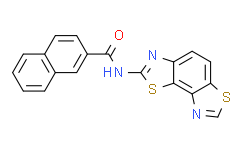| Cas No.: | 1428729-56-9 |
| Chemical Name: | N-(Benzo[1,2-d:3,4-d']bis(thiazole)-2-yl)-2-naphthamide |
| Synonyms: | KIN1148;N-Benzo[1,2-d;N-(benzo[1,2-d:3,4-d']bis(thiazole)-2-yl)-2-naphthamide;N-([1,3]thiazolo[5,4-e][1,3]benzothiazol-2-yl)naphthalene-2-carboxamide;BCP29251;KIN 1148;AK688999 |
| SMILES: | S1C(N([H])C(C2C([H])=C([H])C3=C([H])C([H])=C([H])C([H])=C3C=2[H])=O)=NC2C([H])=C([H])C3=C(C1=2)N=C([H])S3 |
| Formula: | C19H11N3Os2 |
| M.Wt: | 361.4401 |
| Sotrage: | 2 years -20°C Powder, 2 weeks 4°C in DMSO, 6 months -80°C in DMSO |
| Description: | KIN1148, a small-molecule IRF3 agonist, is a novel influenza vaccine adjuvant found to enhance flu vaccine efficacy. |
| In Vivo: | Prime-boost immunization of mice with a suboptimal dose of a monovalent pandemic influenza split virus H1N1 A/California/07/2009 vaccine plus KIN1148 protect against a lethal challenge with mouse-adapted influenza virus (A/California/04/2009) and induce an influenza virusspecific IL-10 and Th2 response by T cells derived from lung and lung-draining lymph nodes. Primeboost immunization with vaccine plus KIN1148, but not prime immunization alone, induce antibodies capable of inhibiting influenza virus hemagglutinin and neutralizing viral infectivity. Nevertheless, a single immunization with vaccine plus KIN1148 provide increased protection over vaccine alone and reduce viral load in the lungs after challenge[1]. |
| In Vitro: | KIN1148 induces the dose-dependent nuclear translocation of IRF3 in PH5CH8 cells and specific activation of IRF3- responsive promoters. KIN1148 also elicits greater induction of endogenous IRF3-dependent ISG54 and OASL expression by PH5CH8 cells[1]. |

 DC Chemicals' products qualify for U.S. tariff exemptions. We guarantee no price increases due to customs duties and maintain stable supply, continuing to deliver reliable research solutions to our American clients.
DC Chemicals' products qualify for U.S. tariff exemptions. We guarantee no price increases due to customs duties and maintain stable supply, continuing to deliver reliable research solutions to our American clients.





















